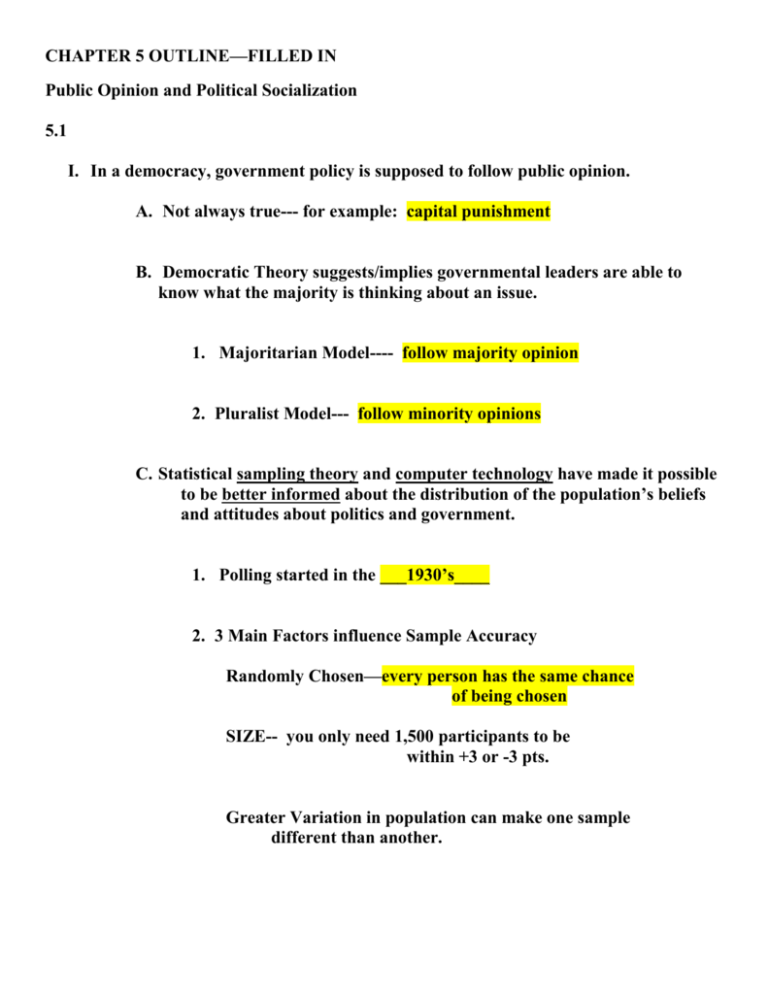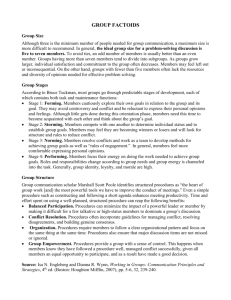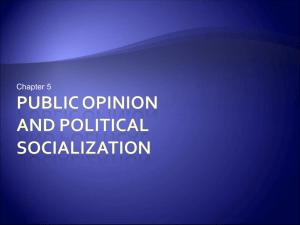chapter 5 filled in outline 2013
advertisement

CHAPTER 5 OUTLINE—FILLED IN Public Opinion and Political Socialization 5.1 I. In a democracy, government policy is supposed to follow public opinion. A. Not always true--- for example: capital punishment B. Democratic Theory suggests/implies governmental leaders are able to know what the majority is thinking about an issue. 1. Majoritarian Model---- follow majority opinion 2. Pluralist Model--- follow minority opinions C. Statistical sampling theory and computer technology have made it possible to be better informed about the distribution of the population’s beliefs and attitudes about politics and government. 1. Polling started in the ___1930’s____ 2. 3 Main Factors influence Sample Accuracy Randomly Chosen—every person has the same chance of being chosen SIZE-- you only need 1,500 participants to be within +3 or -3 pts. Greater Variation in population can make one sample different than another. D. Knowing how often Government policy runs against majority opinion, it becomes harder to defend the U.S. government as democratic under the majoritarian view of democracy. Examples 1. Prayer in Schools 2. Death Penalty 2. Burning the American Flag II. Public Opinion can be analyzed according to the shape and stability of the distribution of opinions among citizens. A. SHAPE__: refers to the pattern or physical form of responses plotted in a graph 1.In a skewed distribution, most of the opinions cluster around a point on one side of the issue. a. Minority opinions risk social ostracism b. Example: gay marriage supporters in Ohio 2004-Issue I 2.In a bimodal distribution, opinions are divided sharply between two opposing points on the issue. a. Great potential for political conflict b. Example---presidential election race 2000, 2004 3.A normal distribution is symmetrically shaped (like a bell) around the most frequent response, called the mode. a. This pattern supports _MODERATE______ government policies b.Example---attitudes on a __LIBREAL-CONSERVATIVE____ Continuum. B. The stability of the distribution refers to the amount of change in the model category or in the shape of the distribution over time. 1. Some political attitudes change little over time a. Example--- capital punishment b. Americans are only slightly more conservative than they were when LBJ launched the Great Society. 2. Segregation has __changed drastically over time_________ III. Political Socialization refers to the complex process by which people acquire their political values. A. Early Learning 1. Primacy Principle—What is learned first is learned best 2. Structuring Principle- what is learned 1st structures later learning B. MOST IMPORTANT agents of early socialization 1. FAMILY 2. SCHOOLS a. Teaches the Importance of national Pride & democratic decision making b. Civic Responsibility 3. COMMUNITY 4. Youthful PEERS C. The socialization process continues in later life through other agents, most notably through 1. College 6. Political Leaders 2. Co-workers 7. Voting Experience 3. Friends 8. Mass Media—Rush Limbaugh, Glenn Beck 4. Neighbors 9. Maturation process 5. Spouses IV. Political values can be usefully analyzed according to social groups. A. Commonalities among people with similar backgrounds B. Commonalities can be seen in the following two questions about trading freedom for order or equality 1. What conditions should abortion be permitted? 2. Should the Government guarantee a job to everyone willing to work C. Responses to these questions were analyzed according to education, income, Region, “old” ethnicity, “new” ethnicity, race, religion and gender. 1. Highly educated people— pick FREEDOM over order and equality 2. Wealthy—oppose to gov’t policy of income redistribution 3. Race-- has emerged as a more critical variable especially in the area of redistribution of wealth 4. Religiosity has increased (How you interpret the bible) 5. Gender factor—women support social programs more 6. Old ethnicity ----Have declined 7. Regional Differences ----Have declined D. The concept of ideology-defined in Chapter 1 as a consistent set of values and beliefs about the proper purpose and scope of government-can be used to interpret public opinion. A. 20% of the electorate are IDEALOGUES--extremists 1. Most Americans are MODERATE 2. Some select moderate because they have characteristics of both parties B. Ideological thinkers are classified more accurately on a 2 dimension typology rather than a single continuum. 1. 1 dimension—original Dilemma—Freedom v. Order 2. 2 dimension—Modern Dilemma –Freedom v. Equality C. Surveys from ch. 1 conclude 1. Liberals 22% 3. Conservatives 32% 2. Libertarians 22% 4. Communitarians 24% D. People do not decide about government according to a one dimensional ideological stand E. For the many people who lack a strong ideological orientation,(Independents)-the proccess of opinion formation involves a number of factors. A. SELF INTEREST—particularly in the economic arena B. Political information: We voice our opinions even when we have no valid information C. Opinion Schemas 1. Many different factors can change an individual’s attitudes 2. Strong correlations between social background and political values D. Policy leaders structure opinions in the absence of information Rush Limbaugh, Glenn Beck, Al Sharpton, Ed Schultz, Chris Matthews








